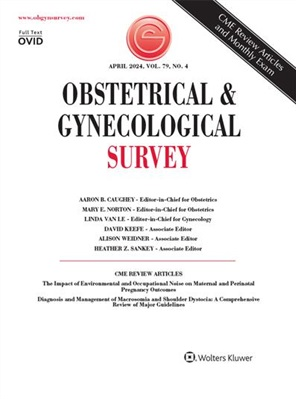Unindicated Cervical Cancer Screening in Adolescent Females Within a Large Healthcare System in the United States
IF 4.3
4区 医学
Q1 OBSTETRICS & GYNECOLOGY
引用次数: 0
Abstract
ABSTRACT The increasingly complicated nature of screening guidelines for cervical cancer includes multiple component tests (cytology, genotyping, and high-risk human papilloma virus [HPV] testing) and evolving recommendations. The aim of this study was assessing single-large-healthcare-system trends over time associated with adolescent females and unindicated cervical cancer screening tests. This repeated cross-sectional study analyzed electronic medical records of provider- and patient-specific variables from the Yale New Haven Health System. Included in the study were all 13- to 20-year-old Yale New Haven Health System patients who underwent screening for cervical cancer via either HPV testing or cytology between January 1, 2012 and December 31, 2018. Age, medical histories, surgical histories, self-reported race and ethnicity, and prescribed medications were all patient-specific variables. Provider-specific variables included clinical practice affiliation, clinical degree, and adolescent patient volume (number of medical visits completed by a patient less than 21 every 6 months). In terms of this study, definition of practice setting was either academic (low-income teaching hospitals) or community-based (private practice setting with primarily insured women). Cytologies were categorized as either unindicated or indicated, based on cervical cancer screening guidelines from 2012 (recorded as unindicated for index specimens collected before the 21st birthday in patients lacking immunocompromised conditions). Should an HPV test be performed, any results other than “atypical squamous cells of undetermined significance” received an unindicated status. The final sample size in the study included 794 women from 118 providers (53% community setting and 47% academic setting). Results from analysis of 900 cervical cancer screenings demonstrated that unindicated tests made up the majority of tests (90%), with 87% of these being unindicated cytology testing only and 14% with unindicated HPV testing as well. Reasons for obtaining unindicated tests as recorded in the original clinical history were lacking, as 62% had no justification listed for testing, and those with reasons failed current guideline compliance. The incidence rate (IR) of adolescent unindicated tests decreased by 33% between 2012 and 2018. Although a significantly lower IR of unindicated screening existed in the academic setting, the rate of decline in the IR of unindicated screening during this period was significantly greater in the community than in the academic setting by 11%. A strength of the study included its ability to calculate IRs in all encounters, including sexually transmitted infection or contraception screenings. Limitations included utilization of hospital system cytology reports for obtaining data, thereby hindering any access to data necessary for validation of screening or surveillance indications from previously performed antecedent cytology. Furthermore, the study failed to collect information regarding another guideline-adherence marker: number of indicated index cervical cancer screenings for patients beginning at 21 years. According to an examination by Becerra-Culqui of women having an encounter at the age of 21 years or beyond, 65% missed opportunities for screening. Finally, the authors were unable to comment on both immunocompromised women and eligible young women who missed indicated screening due to collection of data via pathology reports rather than well-woman examinations. Although unindicated screening for women ages 21 and younger experienced significant reductions, areas for improvement remained. As recent guidelines updates may present greater provider and patient challenges, evidence-based strategies are more important than ever in terms of guideline adherence and dissemination.在美国的一个大型医疗保健系统中,青少年女性的无指征宫颈癌筛查
宫颈癌筛查指南日益复杂,包括多组分检测(细胞学、基因分型和高危人乳头瘤病毒[HPV]检测)和不断发展的建议。本研究的目的是评估单一大型医疗保健系统随时间推移与青春期女性和未指明的宫颈癌筛查测试相关的趋势。这项重复的横断面研究分析了来自耶鲁大学纽黑文卫生系统的提供者和患者特定变量的电子医疗记录。该研究纳入了2012年1月1日至2018年12月31日期间通过HPV检测或细胞学筛查接受宫颈癌筛查的13至20岁耶鲁纽黑文健康系统患者。年龄、病史、手术史、自我报告的种族和民族以及处方药物都是患者特有的变量。提供者特定变量包括临床实践隶属关系、临床学位和青少年患者数量(每6个月少于21名患者完成的就诊次数)。在本研究中,实践环境的定义要么是学术(低收入教学医院),要么是社区(以参保妇女为主的私人实践环境)。根据2012年的宫颈癌筛查指南,细胞学检查分为无指征和有指征两类(在没有免疫功能低下的患者中,在21岁生日之前收集的指数标本记录为无指征)。如果进行HPV检测,除了“意义不确定的非典型鳞状细胞”之外的任何结果都将被视为未指明的状态。该研究的最终样本量包括来自118个提供者的794名妇女(53%的社区环境和47%的学术环境)。对900例宫颈癌筛查的分析结果表明,无指征检测占大多数(90%),其中87%仅为无指征细胞学检测,14%也有未指征的人乳头瘤病毒检测。缺乏原始临床病史中记录的未指示检测的原因,因为62%的患者没有列出检测的理由,而有理由的患者未能遵守现行指南。2012年至2018年期间,青少年无指征检测的发病率下降了33%。虽然在学术环境中存在明显较低的无指筛检IR,但在此期间,社区中无指筛检IR的下降率明显高于学术环境,下降率为11%。该研究的一个优势在于,它能够计算所有接触的风险系数,包括性传播感染或避孕筛查。限制包括利用医院系统细胞学报告来获取数据,从而阻碍了对先前进行的细胞学检查的筛查或监测适应症验证所需数据的任何访问。此外,该研究未能收集到另一个指南依从性指标的信息:21岁开始的患者的指示指数宫颈癌筛查数量。根据Becerra-Culqui对21岁及以上的女性进行的一项调查,65%的女性错过了筛查的机会。最后,作者无法评论免疫功能低下的女性和由于通过病理报告而不是正常女性检查收集数据而错过指示筛查的符合条件的年轻女性。尽管21岁及以下女性的未指明筛查显著减少,但仍有改进的领域。由于最近的指南更新可能会给提供者和患者带来更大的挑战,因此在指南的遵守和传播方面,循证策略比以往任何时候都更加重要。
本文章由计算机程序翻译,如有差异,请以英文原文为准。
求助全文
约1分钟内获得全文
求助全文
来源期刊
CiteScore
2.70
自引率
3.20%
发文量
245
审稿时长
>12 weeks
期刊介绍:
Each monthly issue of Obstetrical & Gynecological Survey presents summaries of the most timely and clinically relevant research being published worldwide. These concise, easy-to-read summaries provide expert insight into how to apply the latest research to patient care. The accompanying editorial commentary puts the studies into perspective and supplies authoritative guidance. The result is a valuable, time-saving resource for busy clinicians.

 求助内容:
求助内容: 应助结果提醒方式:
应助结果提醒方式:


